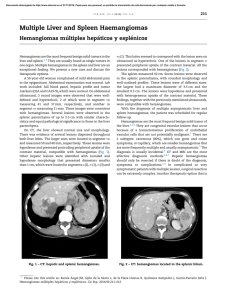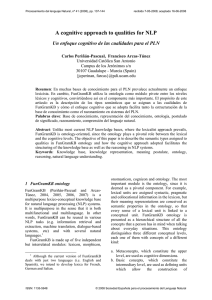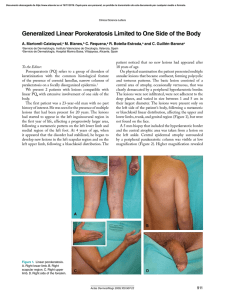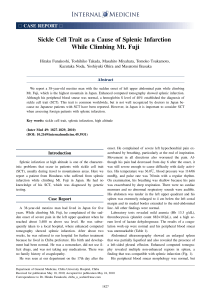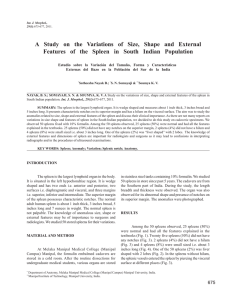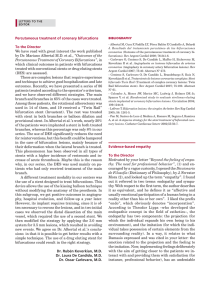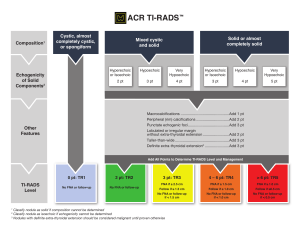CR_2311-Casanova.ing_PLANTILLA CARTA DIRECTOR
Anuncio
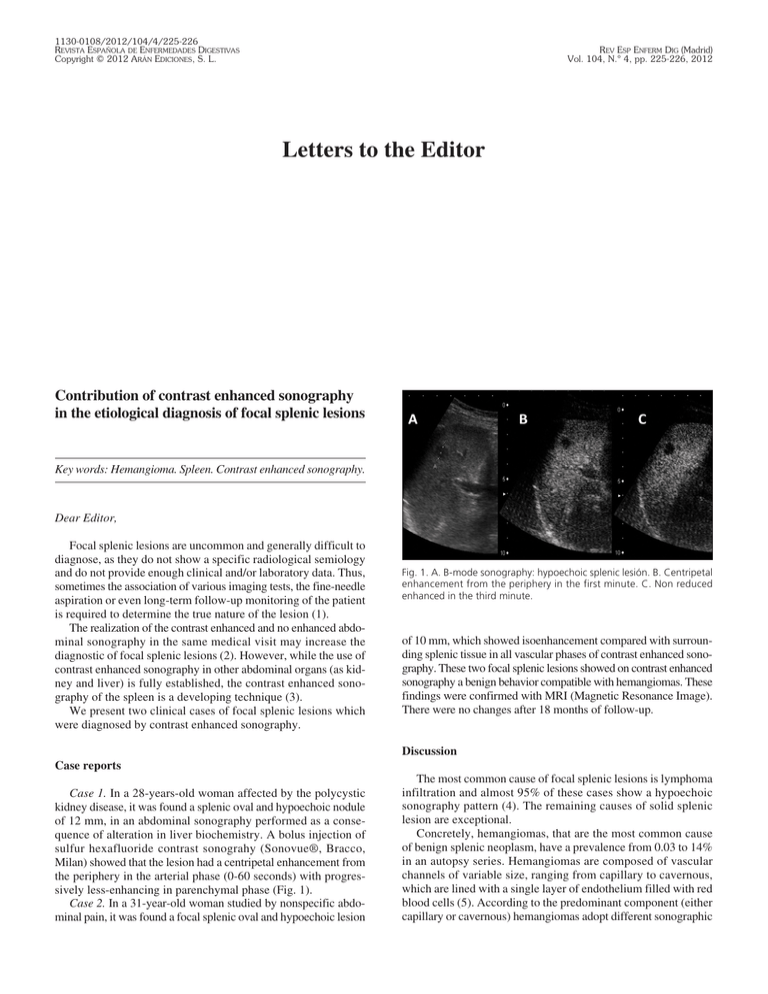
1130-0108/2012/104/4/225-226 REVISTA ESPAÑOLA DE ENFERMEDADES DIGESTIVAS Copyright © 2012 ARÁN EDICIONES, S. L. REV ESP ENFERM DIG (Madrid) Vol. 104, N.° 4, pp. 225-226, 2012 Letters to the Editor Contribution of contrast enhanced sonography in the etiological diagnosis of focal splenic lesions Key words: Hemangioma. Spleen. Contrast enhanced sonography. Dear Editor, Focal splenic lesions are uncommon and generally difficult to diagnose, as they do not show a specific radiological semiology and do not provide enough clinical and/or laboratory data. Thus, sometimes the association of various imaging tests, the fine-needle aspiration or even long-term follow-up monitoring of the patient is required to determine the true nature of the lesion (1). The realization of the contrast enhanced and no enhanced abdominal sonography in the same medical visit may increase the diagnostic of focal splenic lesions (2). However, while the use of contrast enhanced sonography in other abdominal organs (as kidney and liver) is fully established, the contrast enhanced sonography of the spleen is a developing technique (3). We present two clinical cases of focal splenic lesions which were diagnosed by contrast enhanced sonography. Fig. 1. A. B-mode sonography: hypoechoic splenic lesión. B. Centripetal enhancement from the periphery in the first minute. C. Non reduced enhanced in the third minute. of 10 mm, which showed isoenhancement compared with surrounding splenic tissue in all vascular phases of contrast enhanced sonography. These two focal splenic lesions showed on contrast enhanced sonography a benign behavior compatible with hemangiomas. These findings were confirmed with MRI (Magnetic Resonance Image). There were no changes after 18 months of follow-up. Discussion Case reports Case 1. In a 28-years-old woman affected by the polycystic kidney disease, it was found a splenic oval and hypoechoic nodule of 12 mm, in an abdominal sonography performed as a consequence of alteration in liver biochemistry. A bolus injection of sulfur hexafluoride contrast sonograhy (Sonovue®, Bracco, Milan) showed that the lesion had a centripetal enhancement from the periphery in the arterial phase (0-60 seconds) with progressively less-enhancing in parenchymal phase (Fig. 1). Case 2. In a 31-year-old woman studied by nonspecific abdominal pain, it was found a focal splenic oval and hypoechoic lesion The most common cause of focal splenic lesions is lymphoma infiltration and almost 95% of these cases show a hypoechoic sonography pattern (4). The remaining causes of solid splenic lesion are exceptional. Concretely, hemangiomas, that are the most common cause of benign splenic neoplasm, have a prevalence from 0.03 to 14% in an autopsy series. Hemangiomas are composed of vascular channels of variable size, ranging from capillary to cavernous, which are lined with a single layer of endothelium filled with red blood cells (5). According to the predominant component (either capillary or cavernous) hemangiomas adopt different sonographic Vol. 104, N.° 4, 2012 LETTERS TO THE EDITOR patterns. The most frequent hemangiomas are the cavernous ones and characteristically appear as hyperechoic lesions (6). On the contrary, capillary hemangiomas are usually hypoechoic lesions. As hypoechoic splenic lesions are malignant in a high proportion of patients, we performed contrast enhanced sonography to clarify the actual nature of the lesions in our two cases, obtaining an excellent result in both of them. In conclusion, contrast enhanced sonography of the spleen, is an easy, safe and developing technique that could complete the etiological study of focal splenic lesions. References 1. 2. 3. 4. 5. Laura Casanova-Martínez, Eva Marín-Serrano, Marta JaquototHerranz, Pedro Mora-Sanz and José María Segura-Cabral Department of Gastroenterology. Hospital Universitario La Paz. Madrid, Spain 226 6. Abbott R, Levy A, Aguilera N, Gorospe L, Thompson W. Primary vascular neoplasms of the spleen: Radiologic-pathologic correlation. Radiographics 2004;24:1137-63. Catalano O, Sandomenico F, Matarazzo I, Siani A. Contrast-enhanced sonography of the spleen. AJR Am J Roentgenol 2005; 184:1150-6. Görg C. The forgotten organ: contrast enhanced sonography of the spleen. Eur J Radiol 2007;64:189-201. Marín Serrano E, Prieto Villegas M, Segura Cabral JM. Ecografía del bazo. En: Segura Cabral JM, editor. Ecografía Digestiva. 2ª Edición revisada y ampliada. Madrid: Producción Gráfica UAM; 2011. p. 159175. Stang A, Keles H, Hentschke S, Von Seydewitz CU, Dahlke J, Malzfeldt E, et al. Differentiation of benign from malignant focal splenic lesions using sulfur hexafluoride. Filled microbubble contrast enhanced pulse inversion sonography. AJR Am J Roentgenol 2009;193:709-21. Willcox T, Speer R, Schlinkert R, Sarg M. Hemangioma of the spleen: presentation, diagnosis, and management. J Gastrointest Surg 2000; 4:611-3. REV ESP ENFERM DIG 2012; 104 (4): 225-226
